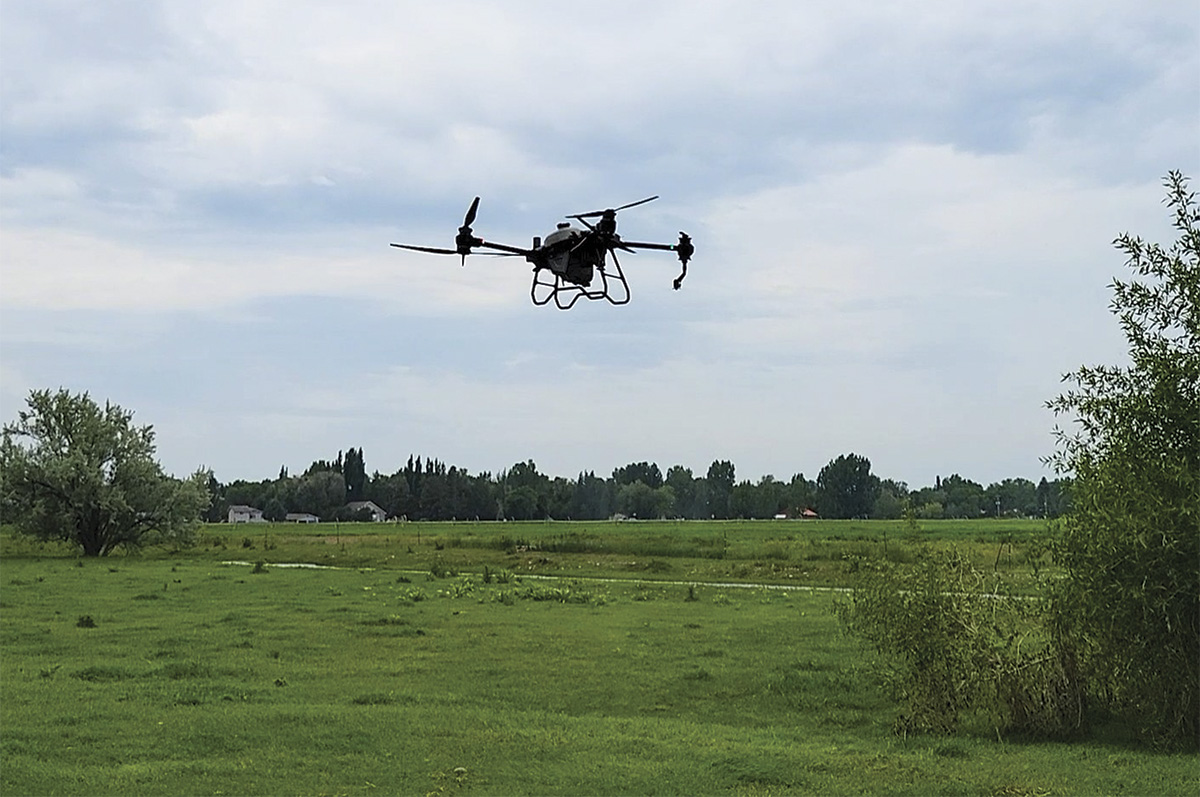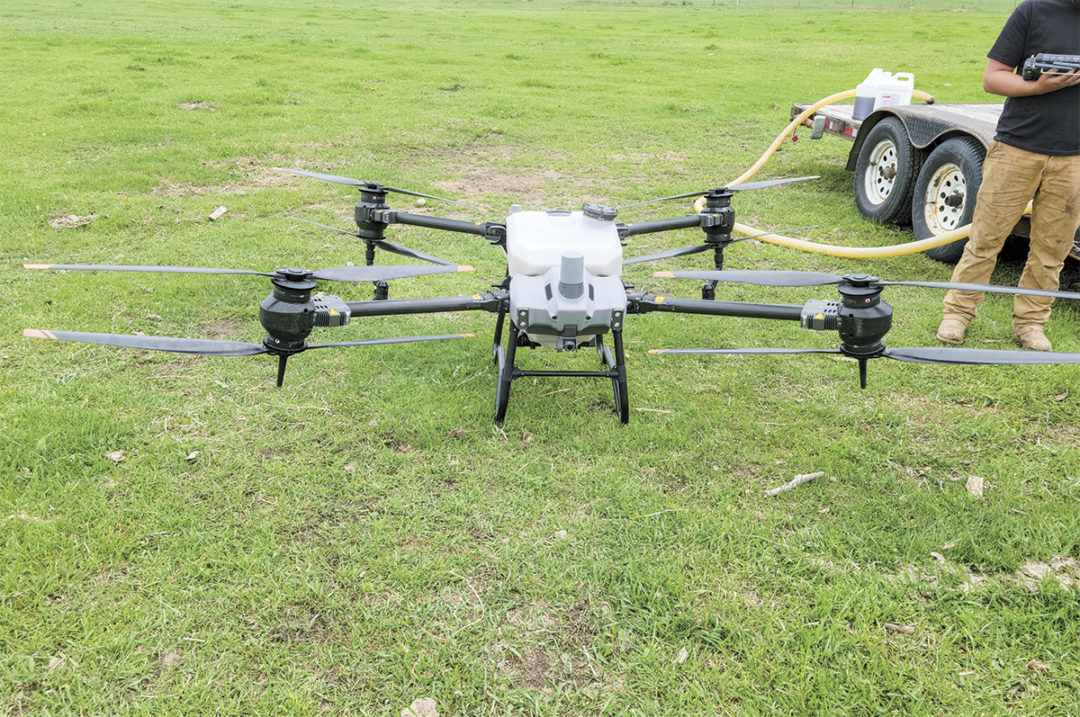“I think within the next five years, it’s just going to take our breath away at the things these drones will be able to do,” says Wade Clark, owner of Clark Ag LLC. However, the current capabilities of a drone might take away your breath right now.
Today, drones have the ability to spray herbicides, pesticides and fungicides at 8 feet off the ground. They also can spread solids like seeds, bugs and compost. They do it quietly, quickly and precisely.
Drones of today
In America, drone spraying is still in its infancy; the toddler stage is coming up fast. In Asia, the vast majority of crops are already treated exclusively with drones.
“Last year, we sprayed several thousands of acres of fields,” notes Cedro Toro, owner of Avary Drone, based in Lehi, Utah.
Clark and Toro are using drones to spray all the typical Idaho crops: potatoes, grain, alfalfa, corn, etc. The process just looks a little different from traditional spray methods.
When a field is to be sprayed using a drone, the drone operator will come to the farm pulling a trailer set up with a spray drone, a water tank/mixing station and generators. The operator will map the field, programming the drone on exactly where to spray and what obstacles to avoid. Current drone models can carry up to 120 pounds of weight and spray a set rate of 2-10 gallons per acre. Most commercial drones have a 10.5 gallon tank. Spray drones are battery operated, so throughout the job, the batteries will be replaced and the tanks refilled – about every eight to 15 minutes, depending on the model and work being performed. Clark refers to this process as a “pit stop.” Large 10,000-watt generators quickly charge backup batteries to reduce downtime and keep the drone in the air.
That said, sprayed acres per hour varies greatly depending on how much total solution needs to be applied.
“At a 2-gallon-to-the-acre application rate, for one drone, you can hit upwards of 60 acres per hour continuously, including your pit stops,” says Clark. “In four hours, you can get 240 acres sprayed.”
At higher applications, 5 to 7 gallons per acre, production slows down significantly. “You’re only doing 20 to 30 acres an hour with that kind of an application rate,” he adds.
What a spray drone lacks in capacity, it makes up for in versatility.
“If the fields are wet, they can still get out and spray them,” says Clark of the options drones offer versus ground rigs.
Additionally, irrigation equipment can be left in place. Drones don’t compact the soils. They don’t damage a maturing crop by knocking over stocks or stems. For seed crops, like those in the Treasure Valley, drones make even more sense, explains Toro.
“You can spray a seed field every five days and get really good results with the drone and take care of all your smaller fields,” he adds.
In comparison to other aerial applicators, “They’re quite a bit more accurate as far as application goes. They’re able to get out and make sure you get the edges all done just right,” Clark says.
Drones can fly within a 5-centimeter level of accuracy, explains Toro. They only fly where you tell them to, and we can control the droplet size very precisely.
Drones really shine in areas with bordering trees, power lines and homes because they are not as intrusive as other aerial applicators.
“The ability for the drones to just kind of show up and do the job without anybody noticing is a big plus,” says Toro, especially when the farmer doesn’t get any complaints later.

Spray drones are ideal for small-acreage fields, fields with obstacles like trees and power lines, and fields in close proximity to homes and businesses. Photo by Paige Nelson.
A spray drone’s ability to spot spray has landowners and county weed control programs alike investing in the technology.
“You see a lot of counties are starting to work with drones because the drones are able to spot treat different areas so much faster than you could ever do it with a person wearing a backpack,” Toro points out.
The drones that Clark and Toro operate and sell have the capability to spread solids, too. One of Clark’s customers recently used his drone to spread compost over the snow and reported back that it worked well and had a good pattern on it.
According to Toro, drones are being used for rangeland restoration projects like overseeding grass or distributing wildflower seeds. They can even dispense beneficial bugs on crops. They can do more than just spray. Imaging drones can perform normalized difference vegetation index analysis, allowing growers to identify problems with watering or insects before these problems are visible to the naked eye. Using lidar, drones can accurately map the land’s surface, helping growers prevent runoff and evenly irrigate crops.
Clark Ag covers mostly eastern Idaho from Fremont County to Bear Lake County. They charge a $300 minimum fee to spray, and the cost per acre will float between $10-$20 per acre, depending on the application rate that is required.
Avery Drone operates spray drones throughout Idaho with drone hubs in Boise, Twin Falls and Blackfoot. Spray costs range from $15 to $22 an acre, depending on the complexity of the mix and the application rate.
To get the best price, Toro encourages farmers to form cooperatives with their neighbors.
“Cooperatives allow us to lower costs for the growers while at the same time providing better service. The co-op is our top priority,” he explains.
Drones of tomorrow
Current laws and licensing permit only one operator per drone, which definitely slows production. Clark is hoping that will change with the advent of what’s called swarming. Swarming is a fleet of drones (typically four) spraying the same field at the same time.
“You’re going to be able to knock out a thousand acres a day with them,” he says.
Right now that kind of operation is illegal, but according to Clark, that rule is currently before the Federal Aviation Administration (FAA), and they are trying to work through the logistics so exemptions can be offered on a commercial scale.
Toro is seeing more and more drones being used for livestock and wildlife purposes. Drones are capable of identifying individuals, moving herds from pasture to pasture and capturing pasture biomass removal analysis, allowing managers to see how much forage the animals are collectively eating on a daily basis.
However, it gets even cooler than that! Toro says drones outfitted with infrared cameras can detect an individual bovine’s heat signal and diagnose whether the animal is within normal range, running a temperature or pregnant.
It’s clear the capabilities of drones increase with every creative mind willing to question the status quo. With no shortage of challenges in agriculture, problem solvers and their toolboxes are always welcome.
Anyone interested in purchasing a drone or needing help getting licensed through the FAA is welcome to reach out to Clark (208) 221-3221 or Toro (208) 473-1010.
What to expect from a drone
The spray drones on the market today have similarities but lots of differences – especially the number and position of rotors and the number, type, location and configuration of nozzles. It begs the question: Which drone is best?
“We don’t really know,” says Earl Creech, extension agronomist and professor at Utah State University. “The fact that every company seems to have a totally different setup for its drones suggests that there’s really no consensus about what works best.”
The technology surrounding spray drones changes rapidly. “I wouldn’t be surprised if the drone we have today is completely obsolete in five years,” says Creech. “There will be something totally new that we haven’t even thought of yet.”
Drone capabilities
According to Creech, a new-model spray drone can spray 2-5 gallons per acre at around 10 feet above the ground, travel at 10-20 miles per hour and, on average, spray 40 acres per hour. All drones are outfitted with a terrain sensor that maintains the drone’s optimum flight height in hilly or uneven terrain. Average flight time is five minutes. Drones calculate their battery life and amount of spray in the tank and return on their own before either is empty.
Depending on the drone package, prices range between $20,000-$40,000.
Most spray drones have traditional flat fan spray nozzles, but the newest spray design uses a controlled droplet atomizer (CDA).
“Basically, you have a spinning disc that throws off little spray droplets that are very uniform in size and [lets] you spray with low pressure. The turbulence created by the drone pushes that spray down into the crop,” explains Creech.
This technology is exciting, he says, but we need more research on how a drone’s spray performance compares to conventional sprayers. Drones can distribute an uneven spray pattern due to the propellers pulling droplets into the downdraft while blowing smaller droplets away from the target zone.
“Lack of spray uniformity with a drone can be a challenge with herbicides because growers have very little tolerance for weed escapes or spray skips,” Creech notes. “It is not as big of a deal with insecticides and fungicides.”
Overall, drones are not a direct replacement for ground rigs, says Creech, due to the speed and uniformity of boom sprayers. But they are an exciting technology with a myriad of applications that will continue to increase in benefit for agriculture.


.jpg?t=1687979285&width=640)


.jpg?height=auto&t=1713304395&width=285)


